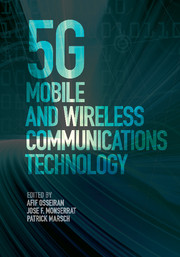Book contents
- Frontmatter
- Dedication
- Contents
- List of contributors
- Foreword
- Acknowledgments
- Acronyms
- 1 Introduction
- 2 5G use cases and system concept
- 3 The 5G architecture
- 4 Machine-type communications
- 5 Device-to-device (D2D) communications
- 6 Millimeter wave communications
- 7 The 5G radio-access technologies
- 8 Massive multiple-input multiple-output (MIMO) systems
- 9 Coordinated multi-point transmission in 5G
- 10 Relaying and wireless network coding
- 11 Interference management, mobility management, and dynamic reconfiguration
- 12 Spectrum
- 13 The 5G wireless propagation channel models
- 14 Simulation methodology
- Index
- References
10 - Relaying and wireless network coding
Published online by Cambridge University Press: 05 June 2016
- Frontmatter
- Dedication
- Contents
- List of contributors
- Foreword
- Acknowledgments
- Acronyms
- 1 Introduction
- 2 5G use cases and system concept
- 3 The 5G architecture
- 4 Machine-type communications
- 5 Device-to-device (D2D) communications
- 6 Millimeter wave communications
- 7 The 5G radio-access technologies
- 8 Massive multiple-input multiple-output (MIMO) systems
- 9 Coordinated multi-point transmission in 5G
- 10 Relaying and wireless network coding
- 11 Interference management, mobility management, and dynamic reconfiguration
- 12 Spectrum
- 13 The 5G wireless propagation channel models
- 14 Simulation methodology
- Index
- References
Summary
Relaying and network coding are powerful techniques that improve the performance of a cellular network, for example by extending the network coverage, by increasing the system capacity or by enhancing the wireless link reliability. This chapter focuses on relaying and wireless network coding in 5G. After reviewing the history of relaying, the key envisioned scenarios for relaying in 5G are highlighted, namely the provisioning of wireless backhaul in Ultra-Dense Networks (UDNs), for nomadic cells or for data aggregation in the context of massive machine-type communications. While full-duplex technology is slowly gaining maturity, it is expected that due to complexity reasons most relaying scenarios in 5G will be based on half-duplex devices. Therefore, finding solutions to overcome the half-duplex limitation remains critical. The chapter describes the following three key innovations for efficient half-duplex relaying:
• By applying the principles of wireless network coding to distributed multi-way traffic, in-band relaying becomes a spectrally efficient solution for wireless backhaul in ultra-dense networks of small cells, despite conventional views.
• Non-orthogonal multiple access techniques, as required by physical-layer network coding, are essential for increased spectral efficiency when simultaneous multi-flows are exchanged through a same relay. Here, Interleave-Division Multiple-Access (IDMA) is put forward for its ability to support flexible rate requirements.
• Buffer-aided relaying is featured where different ways to exploit buffering are described for improved diversity and increased rates. This technique targets delay tolerant applications having high data rate requirements.
The role of relaying and network coding in 5G wireless networks
Relaying was a common technique used to convey messages over large distances in ancient empires such as Egypt, Babylon, China, Greece, Persia and Rome [1]. The messages were transmitted in various forms, such as beacon fires relayed by towers or mountain peaks. A more common method was sending messengers on horseback between Relay Stations (RSs) until the final destination was reached. With the advent of science, communication techniques improved. In 1793, the Chappe brothers of France proposed a telegraph system relying on RSs equipped with telescopes and lighted by lamps.
In modern times, RSs were initially simple devices that amplify a signal and forward it immediately, and were mainly intended to extend the coverage of the wireless system. These were low-cost devices, compared to Base Stations (BSs), that did not include any baseband processing, and hence no network protocol operation was possible.
Information
- Type
- Chapter
- Information
- 5G Mobile and Wireless Communications Technology , pp. 277 - 302Publisher: Cambridge University PressPrint publication year: 2016
